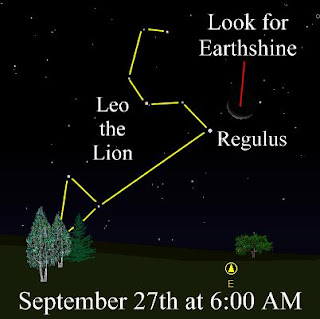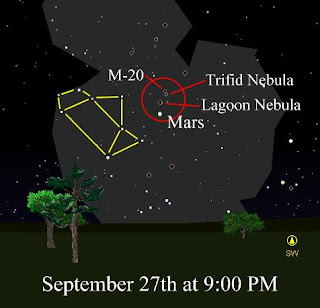September 1 – 7
Venus reappears as the Evening Star this month. You’ll find it very low in the west at 8:30 PM on the 1st. An additional treat is the very thin crescent moon on the 2nd. At just 1.5 days old, it may be difficult to detect in the still lukewarm evening sky. That means your binoculars will come in handy. For a final challenge, see if you can detect Jupiter. It appears as the only star to the right of both Venus and the moon. It’s much closer to the moon than Venus is to the moon, meaning Jupiter might help you locate the moon rather than the other way.The moon reappears in the very low west on the evening of the 2nd. To see it, you’ll want to use your binoculars. First, find Venus, the brightest star in the low west at 8:30 PM. Then look slightly right of Venus through your binoculars to see the moon. The moon will be approximately 36 hours past new, which is younger than most people have seen the moon. You might even catch a glimpse of Jupiter on the moon’s right. This will be among your last chances to see the giant planet until October.
For the rest of the first week, keep your eye open for Earthshine. It appears as a faint illumination of the right side, or Eastern hemisphere of the moon. Binoculars make it easier to see. You can even make out some of the lunar maria on the dark side of the moon in Earthshine.
September 8 – 14
Saturn is the creamy white star below the moon on the evening of the 8th. The pair is less than 4 degrees apart and will therefore fit comfortably together in your binoculars. In a telescope, Saturn appears so serene. Below its exterior however, howl winds faster than 1,000 miles per hour. You’ll need a small telescope or even spotting scope to see the planet’s rings. In about seven years, those rings will turn edge on and become invisible in some telescope.
The moon reaches first quarter phase on the evening of the 9th. First quarter phase is a great time to observe the moon in your binoculars or small telescope. With the boundary between day and night turned directly towards Earth, shadows cast by the rising sun will extend their greatest distance across the lunar surface from our perspective. That accentuates small changes in lunar elevation and helps to make the moon’s surface appear more jagged than it actually is. In reality, the lunar surface is for the most part, rounded and very dusty from the relentless bombardment of micrometeorites and cosmic rays.
Mars is the bright orangish star you’ll find to the lower left of the moon on the 9th. Their distance apart is too great to let both to be seen together in binoculars. Besides, Mars appears as just an orange star in binoculars.
Hey, you’ll find a teaspoon to the left of the moon on the 10th and a teapot below the moon. The teaspoon and teapot shaped pattern of stars are most of the constellation of Sagittarius the Archer. However, it’s easier to see a teaspoon and teapot with these stars than it is to see a Centaur and his bow and arrow.
The moon has company on the 14th. The region surrounding the moon is a watery part of the sky and the only bright star is Fomalhaut. Fomalhaut is the alpha star of the constellation of Pisces Austrinus, or the Southern Fish. Fomalhaut marks the mouth of the fish, which is swimming eastward. Above Pisces Austrinus is the constellation of Aquarius the Water Bearer. Aquarius is pouring water out of an opened jar and the fish below is swallowing it. At least that’s what the sky charts would have you believe.
September 15 – 21
One planet the ancients did not see, but could have had they knew what they were looking for is Uranus. Uranus is an ice giant and the solar system’s 6th planet. Astronomer William Hershel discovered it telescopically over 230 year ago but can just reach naked eye visibility. As a result, it’s quite easy to see through binoculars. However, due to its faintness, it helps to when a brighter easy to find object is near by, as is the moon on the 18th.On the 18th at 11 PM, place the moon at the bottom of your binoculars and you’ll see a star just to the left of the moon. Now go nearly straight up for a binoculars field of view to find a second star that’s the same brightness as the first. Make a turn to the right and you’ll see a line of three fainter stars in a line. The third star is Uranus. If you move your binoculars straight down, the moon will enter the view at the bottom just after Uranus leaves.
The moon will also help you locate the constellation of Aries the Ram on the 18th. The Ram appears as three stars arranged in a slightly curving line. The constellation’s brightest star is named Hamal and it’s the star located in the east and to the moon’s upper left at 11:00 PM. The rest of the constellation consists of two stars further to the left of Hamal. There’s not much more to this constellation other than being able to say you can identify it when most other people can’t.
The moon forms a triangle with two bright and brash star clusters on the 20th. Look in the low east after 11:30 PM to see the Pleiades, or the Seven Sisters above the moon and the larger, but sparser Hyades to the lower left of the moon. The Hyades and Pleiades are classified as galactic star clusters. However, the Pleiades and Hyades are very different in appearance. The Pleiades will show a dipper-shaped pattern of stars in binoculars and you might see as many as two dozen member stars. The Hyades will fill your binoculars field of view with stars, but the stars will be further apart. A nicer contrast in star clusters can’t be had this side of the galaxy.
September 22 – 30
Orion is a winter constellation. This means you can see it in the later summer if you want to get up early in the morning. For those Early Birds up and about by 3:00 AM on the 22nd, look for Orion and the moon in the east. It really appears Orion has just hit a tennis ball. The tennis ball is the moon and Orion’s tennis racket is the arm above his head. The Autumnal Equinox occurs on the morning of the 22nd. At that moment, Autumn begins in the Northern hemisphere. If you were to observe Earth and the sun from a distance, you’d notice that the orientation of Earth’s equator places it directly below the sun. For the next six month, the sun will be located directly over the Southern hemisphere. That leaves the Northern hemisphere with glancing sunlight and longer nights. As a result, it gets cold up here.
Are you looking for a small star cluster to see in your binoculars? Well, M-35 is just 6 degrees to the moon’s upper left on the morning of the 23rd. To see it, go outside at about 5:00 AM. Aim you binoculars at the moon and then shift your view to the upper left of the moon. Just after the moon leaves the field of view at the 4:00 o’clock angle, little M-35 will appear in the 10:00 o’clock angle.
Even if you have trouble finding M-35 on the 23rd, you’ll enjoy looking at the moon. That’s because the moon is in the third quarter phase, or half full. You’ll find lots of craters in the moon’s Southern hemisphere. You’ll find more and larger lunar maria in the moon’s Eastern hemisphere than you do in the Western hemisphere. The largest takes up most of the eastern edge of the moon and it’s called the Ocean of Storms.
Keep you eyes open for Earthshine after the 24th. As you drive on the 25th and after, you moon will appear in the low east. Its right side will appear faintly illuminated by sunlight reflected off Earth.
Mercury becomes a morning star from the 25th and until the end of month. Look for Mercury in the low east at about 6:30 AM. You can’t miss Mercury; it’s the first star you’ll see in the low east. In a few days, the moon joins Mercury.
On the morning of the 26th, the Beehive star cluster is visible 6.5 degrees to moon’s upper left. Even closer to the moon’s right is M-67, a smaller star cluster. Both star clusters belong to the constellation Cancer the Crab. To find the Beehive, point your binoculars at the moon and shift your gaze nearly straight up. Soon after the moon leaves, a tight bundle of stars will enter from the top. The star cluster M-67 is easier to find, but more difficult to see on account of its smaller size. Again point your binoculars at the moon, but this time, don’t move them. Just off the right edge of the moon will be M-67. It should appear as a small fuzzy spot.
The very thin crescent moon picks up a companion star on the morning of the 27th. The star is named Regulus and it’s to the moon’s lower left. Regulus is the brightest star of Leo the Lion.
Look for Mars after it gets dark of the night of the 27th. Mars appears as an orangish star in the south-southwest. Above it are several of the brighter star clusters and nebulae in the constellation of Sagittarius the Archer. To see the star clusters and nebulae, aim your binoculars at Mars and shift your gaze upwards. Mars and the star clusters and nebulae will all fit within your binocular’s field of view.
Mercury reaches greatest western elongation on the 28th. You’ll see Mercury as the reasonable bright white star below the very thin crescent moon. You’ll need to look for it in the low east at 6:30 AM.
This Month’s Sources
Astronomical Phenomena of the Year 2016, The Nautical Almanac Office and Her Majesty’s Nautical Almanac OfficeAstronomy Calendar of Celestial Events for Calendar Year 2016, http://www.seasky.org/astronomy/astronomy-calender-2016.html
Cassini, http://www.nasa.gov/mission_pages/cassini/whycassini/planet.html
Kochab and Pherkad, guardians of the north, http://earthsky.org/brightest-stars/kochab-and-pherkad-gaurd-the-north-celestial-pole
Night Sky Explorer
Dark Skies and Bright Stars,
Your Interstellar Guide
















No comments:
Post a Comment